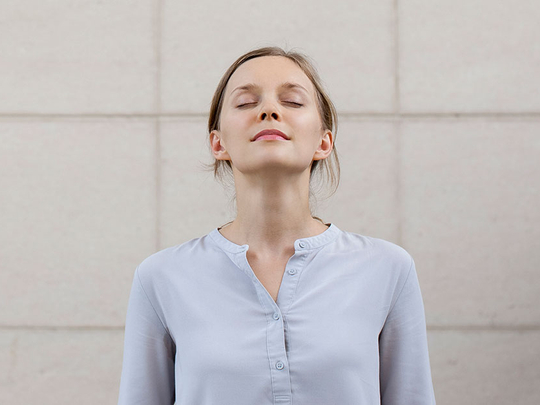
Are you sitting comfortably? Airways clear, back straight, no respiratory conditions? OK. Take a series of short, deep breaths. Activate your diaphragm, pull the air right down into your belly, let the chest fall. Repeat 30-40 times. Feeling a little floaty? Fingers tingling? Don’t worry. It’s just oxygen saturating your cells.
Now take a big breath, then expel all the air from your lungs and hold it. Relax, you’ll be fine. (As long as you’re not doing this in a swimming pool.) That slight feeling of panic? It’s nothing to worry about. You might be surprised how long you can push it before you have to take a huge gasp.
After three attempts, I managed three minutes 23 seconds of not breathing. The person who formulated this exercise, Dutch endurance specialist and multiple world record holder Wim Hof, 59, has trained himself to go up to six or seven minutes. He claims that by performing this exercise daily (along with a regimen of cold showers and meditation), we can help treat a whole suite of conditions and diseases, from depression to arthritis. “It’s so simple,” he tells me. “That’s why people overlook it. They stay in their brains thinking, ‘This cannot be so simple.’ But it is!”
While Hof may be the most eccentric person to tout breath as a panacea for the 21st century, he is not alone. I first started noticing how fashionable breathing had become when I moved to Los Angeles in 2016. One of the first people I met, an English film producer, had just had the word ‘BREATHE’ tattooed on her wrist. New friends told me about conscious breathwork circles and breathing re-education classes. Hardcore gym types talked excitedly about breathing as a “remote control for the brain”.
Even Hillary Clinton claimed, in her book What Happened, that yogic alternate-nostril breathing was what helped her get over losing the presidential election to Donald Trump: “Breathing deeply from your diaphragm, place your right thumb on your right nostril and your ring and little fingers on your left ...” and so on.
A whole self-care industry has made us doubt everything we do naturally — eat, exercise, sleep — and breathing is at the heart of it all. Since you do it around 16 times a minute, 960 times an hour and 23,040 times a day, there’s an awful lot of room for improvement.
Still sitting comfortably? You can breathe normally now.
It’s cheap to breathe
“Breath has been ignored by the general public,” Dr Belisa Vranich says. I suppose she would say that: a child psychologist by training, she now works at the Ash Centre in New York, an “integrative and functional medicine” practice, where she teaches breathing techniques to firefighters, police officers and soldiers to help them manage stress. “Pulmonologists have been looking at severe dysfunction. Yoga paractioners have been looking at pranayama. But no one has been thinking of the average person like you and me. People are realising that they’ve been completed neglected.”
She has developed a breathing IQ test, designed to measure both lung capacity and breathing style.
In her 2017 book Breathe, she asks further questions: do you sit in front of a computer all day? Did you experience trauma, fear or anxiety as a child? She thinks 95 per cent of us are breathing in a way that is “biomechanically unsound”, which is to say, we’re breathing “vertically” (short, shallow, stressed-out breaths up in our chests) as opposed to “horizontally” (long, expansive, restful breaths that make full use of our lower lung capacity). “Most people have no idea where their lungs are,” she says. She tells me to spread my fingers between my nipples and my belly button. “In the middle is where the biggest part of your lungs are. Not up in your collar bones.”
Humans used to breathe correctly, she says. When a three-year-old breathes, their tummy goes in and out. Same with animals. But at a certain point we started breathing “vertically”. That’s how we’re designed to breathe when we face genuinely stressful situations — but not, say, when our phone pings 150 times a day.
“When you’re looking at these screens, your breathing changes. You’re like an animal in stalking mode. And, if you notice, you’re spending all day taking incredibly small breaths. The only time you’re really breathing is when you take a big, expansive sigh.” Breathing properly, she maintains, is the single most important intervention you can make for your own health. Cheap, too.
Breathing is automatic and not automatic at the same time. Respiratory function is controlled in the brainstem, the part of the brain that controls the basic things that keep us alive, like a heartbeat. You still breathe when you’re unconscious, asleep or anaesthetised. But, in some ways, it’s closer to somatic functions (such as walking) than autonomic, involuntary functions (such as sweating). You don’t have to think about each step you take, you just head somewhere. Your brain automatically adjusts your steps, just as your brain will occasionally insert a sigh when it needs more oxygen. But you can also decide to hold your breath, hyperventilate or, as the more out-there breathwork practitioners promise, use your breath “to journey between the conscious and unconscious mind”.
Comfort zones are killing us
Wim Hof’s patented method (known as WHM) has gained a cult following among bodybuilders, athletes and celebrities, including Oprah Winfrey and Orlando Bloom. Hof holds 26 world records for withstanding extreme temperatures, partly thanks to his breathing technique, and runs retreats in Holland, Poland and Spain; he also sells online courses, while giving away the basics free in his app.
“The autonomic nervous system! The endocrine system! The lymphatic system! The immune system! The vascular system!” he declaims when I Skype him in Holland. “According to science, humans couldn’t actively influence any of these. But we have shown that you can tap into them.”
His thesis is that modern humans live in a comfort zone that’s slowly killing us (and also making us fat: you burn many more calories in the cold).
The American author Scott Carney set out to debunk Hof’s methods for his 2017 book What Doesn’t Kill Us, but ended up broadly convinced. The most credible evidence came in 2014, when a team of researchers at Radboud University in Nijmegen in the Netherlands studied 12 subjects who had followed the Wim Hof Method and found they had an increased ability to resist infection and fight inflammation. The researchers concluded that this had “important implications” for the treatment of diseases that involve excessive inflammation, especially autoimmune diseases. It was a small sample, and it remains to be seen whether it’s the cold exposure or the breathing that’s the crucial factor, but there are a number of further medical trials under way across the world.
Activating your body
Still, the notion that breathing is good for you is one of the least controversial things you could say about the human body.
“All chronic pain, suffering, and disease are caused by a lack of oxygen at the cell level,” wrote Dr Arthur C Guyton in his Textbook Of Medical Physiology in 1956, one of the world’s most widely used medical primers. “Proper breathing nourishes the cells of the body with oxygen and optimises the functioning of the body on all levels.” Studies have shown that conscious breathing exercises such as the 4-7-8 (breathe in for four, hold for seven, out for eight) are beneficial for a wide variety of conditions. Conscious breathing activates the body’s relaxation response, which in turn reduces blood pressure, which in turn lowers the risk of stroke and improves cardiovascular health. It’s also good for digestion and general immunity, both of which are impaired by stress.
Perfect for millennials
A British entrepreneur, Poppy Jamie, 28, tells me she was so inspired by the holotropic breathing workshop she attended in LA that she decided to reassess her whole career. “We were in this room of 40 people, all hyperoxygenated. And it was such a release, I cried for two hours afterwards.”
She decided to “pivot” away from her online accessories brand and concentrate on her wellness app, Happy Not Perfect, which offers a series of exercises and techniques designed to help stressed-out young millennials cope with their hyperconnected lives — a tech-on-tech solution. When she conducted focus groups, Jamie says, the breathing exercises were the most popular part of the app: “My generation found it really difficult to ‘think of nothing’ and ‘meditate’, but breathwork was something they could focus on and feel the physical effects of immediately.” She sees it as being a bit like yoga or mindfulness, but without the complicated bits. “I think more and more people need to hear about breathing. It grounds you in the present moment. In my dreams, there would be a breathing centre on every street corner.”
How to breathe
Put one hand on your belly and one on your chest, between your collar bones. Breathe slowly and deeply from the diaphragm. Your belly should expand in an exaggerated way on the inhale, your top hand should be still. This is the sort of “horizontal” breath you should aim for.
Now do it “wrong” to feel the contrast. Breathe upwards into the chest, so your top hand moves but your bottom hand is still. This is the “vertical” breathing you should try to eliminate.
■ Exercise 1
Perch on the edge of a chair with your back straight. Breathe through your mouth. On the inhale, lean forward while expanding the belly. On the exhale, contract the belly as you lean back — breathe out until you are completely empty. Repeat 20 times. The movement should help situate the breath low in the body.
■ Exercise 2
Lie on your back and place a large book on your belly. Take a deep belly breath so it rises up in your peripheral vision. Repeat 50 times, adding heavier books. This will strengthen your core breathing muscles.
— Adapted from Breathe: The Simple, Revolutionary 14-Day Programme To Improve Your Mental And Physical Health by Belisa Vranich.













